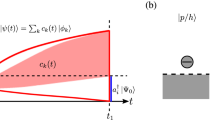Abstract
A semi-phenomenological theory of mass quantisation is presented, wherein different elementary particles are regarded as excited positiveenergy states of a fundamental extensible object. The latter is essentially an elastic continuum which in its quiescent (classical equilibrium) state is believed to be massless and stressless. The classical Hamiltonian describing its oscillations about the equilibrium configuration is constructed by treating the mass-equivalent of the elastic potential energy as the inertial mass occurring in the denominator of the kinetic energy term. Quantisation of the resulting variable-mass oscillator is then effected by following the procedure given by Pauli and Podolsky.
The energy-mass eigenvalues (m n) for the above Schrödinger-like equation are given by
where ƛ0 is the Compton wavelength of the lowest (ground state) eigen massm 0, rc is the measure of the linear dimension of the object, andp n is the nth root of the Bessel function of order 1/3. In view of their infinite lifetime we treat the electron and the proton as the ground states for the two families of particles with baryon numbers zero and unity respectively. Accordingly, for the two families,m 0 andr c are chosen to correspond to the electron and the proton. The calculated mass values show striking agreement with the observed values for the two series.
Similar content being viewed by others
References
de Broglie, L...Introduction to the Vigier Theory of Elementary Particles, Elesevier Publishing Company, Amsterdam, 1963.
Dirac, P. A. M...Proc. Roy. Soc., 1962,268 A, 57.
Einstein, A...The Meaning of Relativity, Methuen & Co., London, 1960.
Gell-Mann, M...Phys. Rev., 1962,125, 1067.
Heisenberg, W. ..Introduction to the Unified Theory of Elementary Particles, Interscience Publishers, 1966.
Hofstadter, R...Ann. Rev. Nucl. Sci., 1957,7, 231.
Katayama, Y. and Yukawa, H.Progr. Theoret. Phys. Suppl., 1968,41, 1.
Pauli, W. ..Handbuch der Physik, 24/1 (Springer), 1933.
Penney, R...Phys. Rev., 1965,137 B, 1385.
Podolsky, B...Ibid., 1928,32, 812.
Author information
Authors and Affiliations
Rights and permissions
About this article
Cite this article
Kumar, N., Muthanna, M. & Sinha, K.P. On mass quantisation of elementary particles. Proc. Indian Acad. Sci. 75, 57–67 (1972). https://doi.org/10.1007/BF03049746
Received:
Issue Date:
DOI: https://doi.org/10.1007/BF03049746



